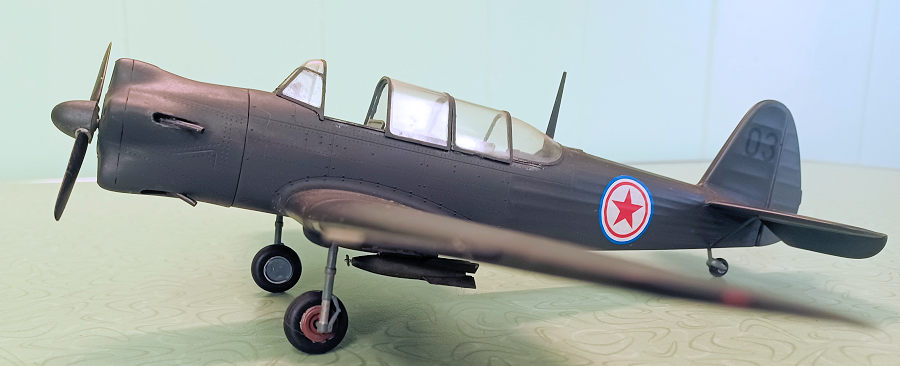
Trumpeter 1/32 Yak-18 Max
| KIT #: | 02213 |
| PRICE: | $20.00 or less |
| DECALS: | Three options |
| REVIEWER: | Christopher Campbell |
| NOTES: |

| HISTORY |
For those who have seen that legendary M.A.S.H. episode, 5 O’Clock Charlie says it all. For the uninitiated, 5 O’Clock Charlie was the title and the subject of the second episode of the second season of the famed Korean War dramedy.
It depicts one of the frequent harassment raids flown during the Korean War, often using antiquated aircraft and even hand tossed bombs. The aircraft used in the episode was a Ryan PT-22 painted in North Korean markings. His “raids” were generally laughable, with bets being taken on where his poorly thrown bombs would land. Charlie would make another appearance in the third season, dropping leaflets instead. While quite humorous on television, these nuisance raids sometimes did actual damage. (More about that later.)
Raids such as this were not unique to the Korean War. They were quite common in the Pacific during W.W.II as well as on the Eastern Front. In the Pacific, Japanese aircraft would sometimes deliberately fly with engines tuned to misfire and create a very irritating sound as they flew over. In that theater almost any sort of aircraft might be employed, though often light bombers, trainers, and observation types. The main purpose of these raids was as much to strike at morale and deprive their enemies of much needed rest as it was to do actual damage. In that respect, it was an effective tactic.
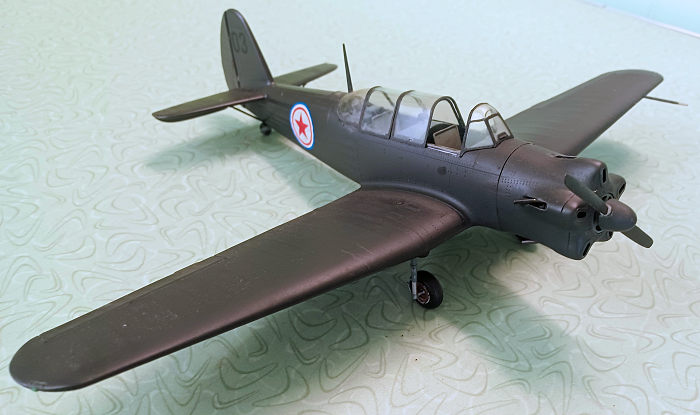 On the Eastern Front, both the Luftwaffe and the
Soviets employed similar tactics. The aircraft of choice for the Soviets was the
Polikarpov Po-2 biplane (this aircraft would see service in the same role in
Korea). Often flown by women, most famously the Night Witches of the all female
588th. Night Bomber Regiment, these raids proved most effective.
On the Eastern Front, both the Luftwaffe and the
Soviets employed similar tactics. The aircraft of choice for the Soviets was the
Polikarpov Po-2 biplane (this aircraft would see service in the same role in
Korea). Often flown by women, most famously the Night Witches of the all female
588th. Night Bomber Regiment, these raids proved most effective.
Fuel and ammunition dumps were often the targets, though precision night strikes were sometimes performed. While there were some losses, the aircraft at its top speed was slower than any fighter in the Luftwaffe could fly and still stay in the air. Interceptions at night while not impossible, were difficult and just as likely to result in a midair collision.
Beginning in 1942, by war’s end, 23,000 missions had been flown. Twenty-three of the pilots from the 588th. Would be awarded Hero of the Soviet Union. In 2013, a Russian television series about the courageous women pilots debuted called Night Swallows. Lasting two seasons, it can be found on some streaming services.
The Luftwaffe took notice of these raids and began employing a very dated aircraft of their own with similar tactics. In this case, it was most commonly the Henschel Hs.123 biplane. Rugged and designed form the onset as bomber, it proved quite adept in this role. It was often flown with the propeller set as such a pitch to create as much noise as possible. It proved so effective in this role that the Luftwaffe inquired with Henschel about the possibility of running off new aircraft as attrition took its inevitable toll. Tooling no longer existed by this time. Thus, remaining aircraft soldiered on until all were expended.
Five years after W.W.II ended, hostilities would flare again in Korea. From the onset, rather unexpected aircraft would be utilized in combat roles for which they had not been designed. In the first few days of the war, South Korean Piper L-4 Cubs would operate with hand tossed bombs, in some cases slowing the North Korean advance when they managed to knock out a tank, blocking the only way through a pass.
The North Koreans and later Chinese would employ light aircraft in the same role as the Soviets had during W.W.II. These were the same sort of harassment raids, often with the same aircraft, the by now somewhat ancient Po-2. However, the Yakovlev Yak-18 would also join the fray, though the tactics remained much the same. Their small displacement radial engines led to the machines being known as Washing Machine Charlies, though this nickname had already been popularized in the Pacific During W.W.II. Due to their frequent night raids, Bedcheck Charlie soon became the accepted nomenclature.
As noted, while the raids often amounted to little, sometimes they hit home. Most infamously, four Yak-18’s struck a fuel dump near Inchon in 1953, resulting in the loss of more than five million gallons of fuel. Something had to be done.
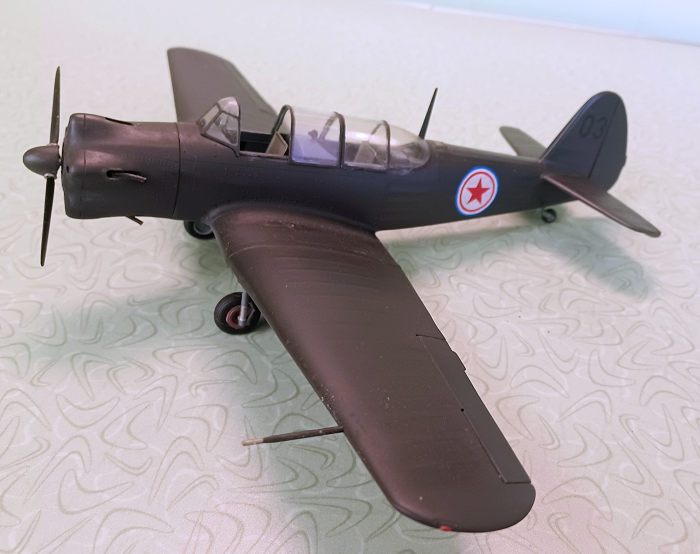 U.S.A.F. and Navy night fighters were tasked with
bringing down the evening interlopers, though with only moderate success. F-94
Starfires, F7F Tigercats, and F3D Skyknights all hunted them, though the speed
differential made closing for a kill quite difficult and dangerous. One F-94 was
even lost when it slowed beyond stall speed during an attempted interception.
The exact figures on kills scored against these night raiders vary slightly.
However, it seems to be less than ten, showing that it was still a sound tactic,
even in the dawning jet age.
U.S.A.F. and Navy night fighters were tasked with
bringing down the evening interlopers, though with only moderate success. F-94
Starfires, F7F Tigercats, and F3D Skyknights all hunted them, though the speed
differential made closing for a kill quite difficult and dangerous. One F-94 was
even lost when it slowed beyond stall speed during an attempted interception.
The exact figures on kills scored against these night raiders vary slightly.
However, it seems to be less than ten, showing that it was still a sound tactic,
even in the dawning jet age.
As for the Yak-18 itself, this aircraft was the product of a 1945 requirement to replace the earlier Soviet UT-2 trainer dating from 1937. It was a simple design of mixed construction with both aluminum and fabric skinning being used.
Powered by a five-cylinder Shetsov M-11 engine producing 160 horsepower, it was a simple, two seat trainer. It was also rugged and easy to maintain in the field, much like the older Polikarpov Po-2 in that respect.
It boasted a top speed of 190 mph. and, as a trainer should be, was easy to fly. Landing gear was semi-retractable and able to tolerate simple, unimproved fields, making it ideal for the role into which it would be thrust when war came again.
First flying in 1946, it would serve with nearly thirty air forces for decades as a primary trainer. It could be found almost anywhere that the Soviets or Chinese had alliances or influence. Initially a tail dragger, tricycle gear would later be added, most prominently in the Chinese produced Nanchang CJ-6 version.
Today, a number of original Yak’s as well as Nanchang aircraft fly as warbirds and private aircraft. As recently as a decade ago, North Korean military aircraft were photographed, showing that they might yet be retained there either as trainers or waiting to be employed in the harassment role yet again.
A later aircraft designated Yak-18T with tricycle gear and a four-place cabin would be produced beginning in 1967 and continuing into the 1990’s. While it bears a superficial resemblance to the earlier type, its main relation is its designation, as it was mostly an original design. While originally produced as a basic trainer for Aeroflot, it would later serve in the liaison role in the Soviet and other air forces.
| THE KIT |
 Released in the early 2000’s, I happened upon this
kit one day while browsing Hobby Lobby on my lunch break around 2009. It was on
a clearance table and priced low enough that I could not resist it. I already
had the original release of the Amodel 1/72 Yak-18 in Bedcheck Charlie colors in
my stash. However, the moment I saw this kit, I realized what I could do with
it: turn it into a larger, eye-catching version of the same.
Released in the early 2000’s, I happened upon this
kit one day while browsing Hobby Lobby on my lunch break around 2009. It was on
a clearance table and priced low enough that I could not resist it. I already
had the original release of the Amodel 1/72 Yak-18 in Bedcheck Charlie colors in
my stash. However, the moment I saw this kit, I realized what I could do with
it: turn it into a larger, eye-catching version of the same.
This was the first Trumpeter kit that I purchased, and I was generally impressed with what I found in the box. As with all Trumpeter kits that I have seen, it is generally well molded with a fairly detailed engine (for what it is). An optional clear cowl is provided for the modeler who wishes to show this off.
The instructions are well detailed and laid out to make assembly easy. Some photo etch is provided, most notably in the form of functional hinges for the elevators and rudders. The instrument panel includes and acetate with printed gauges, giving the finished product a most realistic look. Decals are provided for Soviet, Chinese, and North Korean aircraft, though not the one that I would build, as these were all simple trainers.
| CONSTRUCTION |
As noted, I planned from the onset to build this one as a North Korean Bedcheck Charlie. That being said, there would be very little to change, save adding bombs and racks. Other than that, it would effectively be built straight out of the box.
I started with the engine, assembling it and painting it the hub in Testors Flat Grey. The cylinders and other components were painted in Testors Flat Black and dry brushed with Model Master Anodonic Grey. It is a fairly nice representation of this odd little five-cylinder radial. However, very little of it can be seen through the cowl. This is oft the case with Trumpeter kits, though, and I cannot fault them for producing a reasonably detailed engine for those who want to show it off.
Then the assembly of the cockpit began. It is simple, as this is a simple aircraft. As noted, there is a nice acetate with the gauges printed on it. The instrument panel is modeled with openings to accommodate this and the effect is quite good when finished.
The instrument panel and most of the interior was sprayed with Model Master Soviet Light Grey. Appropriate gauges and knobs were painted in Testors Flat Black and drybrushed with silver with some bits picked out in Red or Yellow as deemed appropriate. The seats were painted in Testors Aluminum, though in retrospect these probably should have been grey as well. Still, it provides some nice contrast in the cockpit.
No seatbelts were included in the kit as I recall. This build was done before I had begun fabricating my own, as well as buckles. Perhaps I should yet add them. The acetate instruments were applied behind the instrument panel and the whole thing was put together per the instructions.
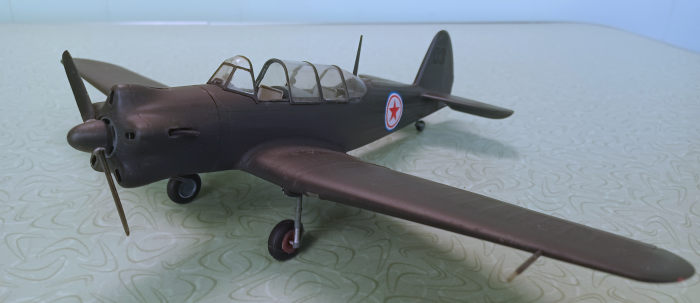 Once the cockpit components were assembled and in
place the fuselage was closed up and glued with CA glue. The engine and cowl
were also installed at this point. Fit proved to be quite good with only a
minimum of filling needed, all of which could be accomplished with CA glue and
some simple sanding.
Once the cockpit components were assembled and in
place the fuselage was closed up and glued with CA glue. The engine and cowl
were also installed at this point. Fit proved to be quite good with only a
minimum of filling needed, all of which could be accomplished with CA glue and
some simple sanding.
The wings likewise proved to be no trouble, being glued up and finished in the same manner. Seams and joints were clean enough to be easily finished sanding with 400 grit paper with finishing done with 0000 steel wool throughout. While some Trumpeter kits have been reported (And experienced!) to have some fit issues, I was quite pleased with everything that I encountered with this kit.
Photo-etch hinges are provided for the elevators and rudder and were simple enough to install. Once assembled, the rudder and elevators will float and droop on these appropriately, just as on the genuine article.
Assembly throughout was done with basic CA glue, also used as a filler when needed. The only spot where I found a genuine need to fill, and this was minor, was at the wing root. All in all, it proved a very easy and trouble-free build.
Once the wings, rudder, and elevators had been cleaned up, assembled, and installed, there was very little left to do. It had been a quick build, especially so given that it was a 1/32 scale kit. Now, it was time to paint the beast.
| COLORS & MARKINGS |
Descriptions of the paint used on these night raiders generally describe it as black or weathered black. All of the builds and illustrations that I have seen of Yak-18 or Po-2 Bedcheck Charlies from Korea seem to show something more a very dark grey than truly black. This was going to be something of a roll my own shade, I quickly realized.
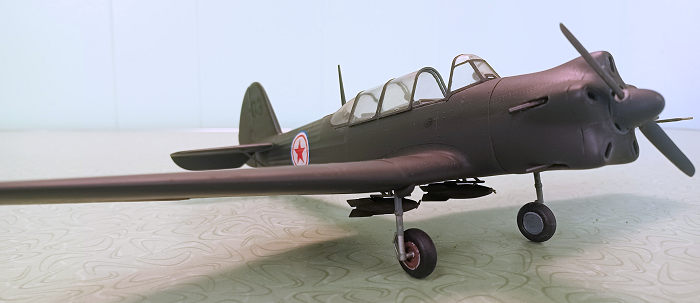 The closest thing out of my paint rack seemed to be
Model Master Luftwaffe Dunkel Grau (Dark Grey) though not quite dark enough. I
added more than a little Model Master Flat Black to it until I had a shade that
I liked. After a few test patches on the work bench, I finally decided that it
had the right tone.
The closest thing out of my paint rack seemed to be
Model Master Luftwaffe Dunkel Grau (Dark Grey) though not quite dark enough. I
added more than a little Model Master Flat Black to it until I had a shade that
I liked. After a few test patches on the work bench, I finally decided that it
had the right tone.
The cockpit was stuffed with bits of damp paper towel and the whole thing was sprayed in my concoction. I was very pleased with the results. It was very dark, though not quite black. The results were very much what I had hoped for.
Selected areas were drybrushed in Model Master Dark Anodonic Grey, especially the wheel wells. Testors Flat Black was also used for weathering in some areas. An acrylic wash based on Tamiya Flat black was used in the area of the fuel filler caps to simulate spillage and general wear.
Satisfied with my results thus far, a coat of Model Master rattle can Gloss was applied. Once this was dry, the kit roundels for North Korea were applied to the fuselage using MicroSol to set them. The tail number came from some nameless and long forgotten sheet in my decal file. The style and size of the numbers and the simple 03 in black seemed right enough for me. By the minute, it was looking ever more like a Bedcheck Charlie that would have prowled the night air above the combat zone.
| FINAL PIECES |
Since I was building one of these infamous harassment aircraft, bombs and bomb racks needed to added. Thus I looked through my spares bins until I saw something that seemed plausible. The bombs came from an old Hasegawa P-26 kit. These, were, after all, field lash-up conversions. Bombs from almost any period might have and likely were used, especially if acquired from Chinese sources.
These were assembled and painted in simple Testors Olive Drab. I gave them a wash and weathered them appropriately, to give the appearance of something that had languished long in some ammo dump. Bomb racks were also obtained from the spares bin, painted and installed along with the bombs with holes for the former being drilled out with a pin vise and a fine bit.
The propeller was painted in Testors Flat Black and the spinner in the same grey as the aircraft. These were weathered with some drybrushing in Testors Aluminum. Once installed, there was only a little left.
Exhaust pipes were fabricated from some fine brass tubing and painted in Model Master Burnt Iron. These were drybrushed in Model Master Dark Anodonic Grey and Flat Black, then glued in place with CA glue.
The landing gear struts were painted in Dark Anodonic Grey as well, oleos accented in Model Master Chrome Silver. The wheel hubs themselves were painted in Anodonic Grey, with Testors Rust for the Brake Drums, with a bit weathering. A few more accents were picked out by drybrushing with Testors Aluminum and the same techniques were used on the tail wheel. The landing fits very positively in the slots provided were attached with a drop of CA.
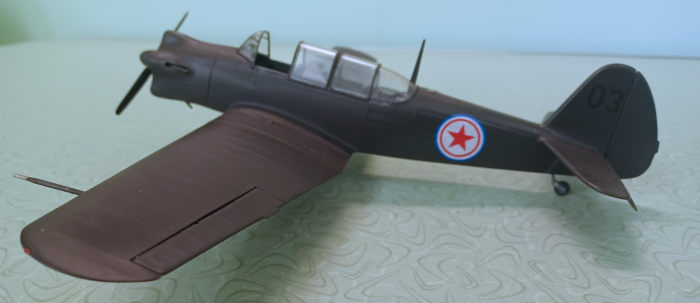 The tires are provided in rubber only. So far as I
can tell, this is not the sort that will eat and destroy your plastic as some
have been. This build is more than a decade old and shows no signs of
degradation. If you have concerns about this, that should lay them to rest.
The tires are provided in rubber only. So far as I
can tell, this is not the sort that will eat and destroy your plastic as some
have been. This build is more than a decade old and shows no signs of
degradation. If you have concerns about this, that should lay them to rest.
The canopy framing was hand painted in the same roll you own shade as the airframe. Interior framing was painted in the same grey as the cockpit. Once this was all done the canopy was clued in place with some lightly applied CA glue. The propeller and spinner were also glued in place and it was effectively done.
Only the radio mast and running lights remained. The former was glued in place without any trouble. Wingtip running lights were picked out with Testors Gloss Green and Gloss red. Then the whole thing was given a coat of Testors Model Master rattle can Dullcoat. Now I had a genuine Korean War Bedcheck Charlie in all of its infamous glory. More so, it had been simple and mostly trouble free build. It was completed over the course of a single weekend, with my working time being about nine hours, I think.
For some reason, I forgot or neglected to install the brake lines. I really must do this, as it completes the look of the gear nicely and needs to be there for realism’s sake. These are provided in the kit. As to why I did not install them, I cannot say or recall.
| CONCLUSIONS |
The Trumpeter 1/32 Yak-18 kit is one of the simpler offerings from this company. The build is easy, and it is a prime kit for those wishing to graduate to somewhat more advanced models. I would recommend this kit to any modeler with a modicum of experience.
It is well within the grasp of most to produce a first rate representation of this simple yet legendary aircraft. Additionally, the choice of liveries is quite extensive. They include countries as varied as the more basic Eastern Bloc along with a myriad of choices from Africa, Asia, the former Soviet state, as well as the Middle East. Since most of these aircraft wore only national insignia with special markings being somewhat rare, sourcing decals should not be too difficult, whatever one might select.
As always, have fun with what you build and Happy Modeling. Always remember, this is a hobby. Take pleasure and satisfaction in all of your endeavors.
| REFERENCES |
https://en.wikipedia.org/wiki/Yakovlev_Yak-18
https://en.wikipedia.org/wiki/Grumman_F7F_Tigercat
https://en.wikipedia.org/wiki/Lockheed_F-94_Starfire
https://en.wikipedia.org/wiki/Douglas_F3D_Skyknight
https://en.wikipedia.org/wiki/Night_Witches
https://en.wikipedia.org/wiki/Washing_Machine_Charlie
https://www.imdb.com/title/tt3577638/
The Encyclopedia of the World’s Combat Aircraft by Bill Gunston, Salamander/Chartwell Books, 1978
28 October 2024
Copyright ModelingMadness.com.
All rights reserved. No reproduction in part or in whole without express
permission from the editor. If you would like your product reviewed fairly and fairly quickly, please
contact the editor
or see other details in the
Note to
Contributors. Back to the Main Page
Back to the Review
Index Page
Back to the Previews Index Page